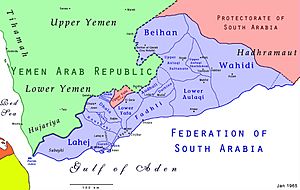Haushabi facts for kids
Quick facts for kids Hawshabi Sultanate of Musaymir
سلطنة الحواشب
|
|||||||
|---|---|---|---|---|---|---|---|
| State of the Federation of South Arabia | |||||||
| 18th century–1967 | |||||||
 Map of the Federation of South Arabia |
|||||||
| Capital | Al Raha (until 1887) Musaymir (from 1887) |
||||||
| • Type | Sultanate | ||||||
| Historical era | 20th century | ||||||
|
• Established
|
18th century | ||||||
|
• Disestablished
|
1967 | ||||||
|
|||||||
The Haushabi Sultanate was a small state in the area that is now part of Yemen. It was also known as Hawshabi or Hawshabi Sultanate. Its main city, or capital, was Musaymir. This sultanate was part of the British Aden Protectorate for many years.
Contents
History of the Haushabi Sultanate
Early Years and British Agreements
The Haushabi Sultanate began in the 1700s. In 1839, Sultan Mana bin Salam, the leader of the Haushabi tribe, made an agreement with the British. This agreement was similar to those made with other nearby tribes. It helped keep peace and friendship between the Haushabi and the British.
Sultan Mana bin Salam was a wise leader. He refused to join other tribes when they attacked Aden, a British-controlled port city. He died in 1858, and his nephew, Ubeid bin Yahya, became the new sultan. Under Ubeid bin Yahya, relations with the British stayed friendly.
Conflicts and Changes in Leadership
In 1863, Ali bin Mana became sultan. His time as ruler was not always peaceful. In 1868, he caused trouble by cutting off water to the nearby Lahej territory. This led to a fight where the Haushabi Sultan was defeated. To make up for the damage, Sultan Ali bin Mana gave the town of Zaida to Lahej.
However, Sultan Ali bin Mana was not happy with this. He tried to get help from Turkish officials to get Zaida back. He even held part of Zaida with Turkish soldiers for a short time. But when the Turkish troops left, he had to retreat.
Later, in 1881, a new agreement was made about Zaida. But in 1886, Sultan Ali bin Mana sold his lands in Zaida to the Abdali tribe. He died in May 1886, and his son, Muhsin bin Ali, became sultan.
Trade and Turkish Disputes
In 1888, Sultan Muhsin bin Ali signed an agreement with other local leaders. This agreement set the prices for goods being traded.
In 1894, Sultan Muhsin bin Ali charged very high taxes on traders. Because of this, the Abdali tribe entered his land, and he had to run away. His own tribal leaders chose the Abdali Sultan to rule instead. Muhsin bin Ali tried to get help from the Turks again, but it didn't work. He then accepted a deal to get his territory back in 1895. He also signed a Protectorate Treaty with the British. This meant the British would protect his state.
Around 1900, a Turkish official built a fort in Haushabi territory. The Turks refused to leave, so the Haushabi Sultan tried to drive them out. When that failed, British forces from Aden helped. They successfully removed the Turks and their supporters in 1901.
In 1903, the borders of the Haushabi Sultanate were officially marked. Sultan Muhsin bin Ali died in 1904, and Ali Mana became the new sultan.
Later Years and End of the Sultanate
From 1905, the good relationship between the Abdali and Haushabi sultans was restored. In 1914, Sultan Ali Mana signed an agreement to keep trade routes safe in his area. He received extra payments for this and agreed to keep a force of 50 men to guard the routes.
In 1915, Sultan Ali Mana joined the Turkish attack on Lahej. However, he later went to Aden in 1919 to ask for forgiveness. He explained that the Turks forced him to join them. The British accepted his explanation, forgave him, and gave him back his regular payments.
In 1922, troops from the Imam of Sanaa entered Haushabi land. They only left after the British used air power to pressure them. In August 1922, Sultan Ali Mana died, and his son, Muhsin bin Ali Mana, took over.
By 1931, the Haushabi population was about 15,000 people. The sultan's yearly income was estimated at about 30,000 rupees.
The last sultan, Faisal bin Surur Al Haushabi, was removed from power in 1967. His state was ended when the People's Republic of South Yemen was formed.
Rulers of Haushabi
The leaders of Haushabi were called Sultan al-Saltana al-Hawshabiyya.
Sultans
- c.1730 – al-Fajjar al-Hawshabi
- c.1800 – Sultan al-Hawshabi
- 1839? – 1 June 1858 – Mani` ibn Sallam al-Hawshabi
- 1858 – 1863 – `Ubayd ibn Yahya al-Hawshabi
- 1863 – 4 May 1886 – `Ali ibn Mani` (I) al-Hawshabi
- 1886 – 1894 – Muhsin ibn `Ali (I) al-Hawshabi (1st time)
- 1894 – 1895 – al-Fadl ibn `Ali (usurper)
- 6 March 1895 – 28 September 1904 – Muhsin ibn `Ali (I) al-Hawshabi (2nd time)
- 1904 – August 1922 – `Ali ibn Mani` (II) al-Hawshabi
- 1922 – 19.. – Muhsin ibn `Ali (II) al-Hawshabi
- 19.. – 19.. – as-Surur ibn Muhammad al-Hawshabi
- 1947? – 1955 – Muhammad ibn as-Surur al-Hawshabi (died 1955)
- 1955 – 29 November 1967 – Faysal ibn as-Surur al-Hawshabi
See also

